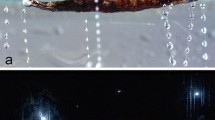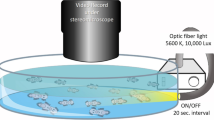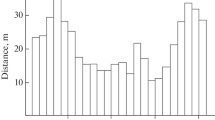Abstract
The planktotrophic trochophore of the serpulid polychaete Spirobranchus giganteus (Pallas) responds positively to visible light of wavelengths shorter than 590 nm. The response does not habituate, remaining effective for at least 2 h. The position and orientation of the 2-celled eyespot suggest that continuous forward movement occurs when the eyespot microvilli are shaded, a condition that could be caused by the pigment cell or by an outside shadow. Comparison with other larvae indicates interspecific differences in both light response and eyespot orientation. At the metatrochophore stage there is a loss of response to white light as well as changes in swimming speed and behaviour.
Similar content being viewed by others
Literature cited
Bhaud, M.: Etude de la migration verticale quotidienne des larves de Mesochaetopteris sagittarius à Nosy-Bé (Madagascar). [Study of the daily vertical migration of the larvae of Mesochaetopterus sagittarius of Nosy-Bé (Madagascar)]. Mar. Biol. 4, 28–35 (1969)
Daro, M. H.: Etude des migrations nycthemerales du zooplankton dans un milieu marin peu profond. Hydrobiologica 44, 149–160 (1979)
Eakin, R. M. and J. A. Westfall: Further observations on the fine structure of some invertebrate eyes. Z. Zellforsch. mikrosk. Anat. 62, 310–332 (1964)
Holborow, P. L. and M. S. Laverack: Presumptive photoreceptor structures in the trochophore of Harmothöe imbricata (Polychaeta). Mar. Behav. Physiol. 1, 139–156 (1972)
Lacalli, T. C.: Structure and organization of the nervous system in the trochophore larva of Spirobranchus. Proc. R. Soc. Lond., Ser. B (In press)
Marsden, J. R.: Morphological evidence for neural activity in prototrochal and neurotrochal cells of the trochophore larva of the serpulid polychaete, Galeolaria caespitosa. Int. J. Invertebr. Reprod. 5, 289–297 (1982)
Marsden, J. R. and D. T. Anderson: Larval development and metamorphosis of the serpulid polychaete Galeolaria caespitosa Lamarck. Aust. J. mar. freshwat. Res. 32, 667–680 (1981)
Segrove, F.: The development of the serpulid Pomatoceros triqueter L. Q. J. microsc. Sci. 82, 467–540 (1941)
Wiseley, B.: The development and settling of a serpulid worm, Hydroides norvegica Gunnerus (Polychaeta). Aust. J. mar. freshwat. Res. 9, 351–361 (1958)
Young, C. M. and Fu-Shiang, Chia: Ontogeny of phototaxis during larval development of the sedentary polychaete, Serpula vermicularis (L.). Biol. Bull. mar. biol. Lab., Woods Hole 162, 457–468 (1982)
Author information
Authors and Affiliations
Additional information
Communicated by R. W. Doyle, Halifax
Rights and permissions
About this article
Cite this article
Marsden, J.R. Swimming in response to light by larvae of the tropical serpulid Spirobranchus giganteus . Marine Biology 83, 13–16 (1984). https://doi.org/10.1007/BF00393081
Accepted:
Issue Date:
DOI: https://doi.org/10.1007/BF00393081




